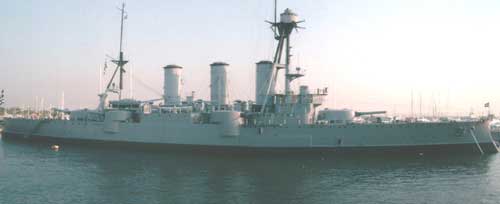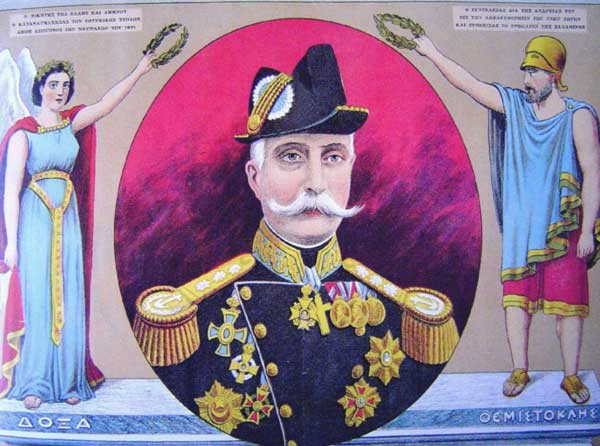.

BS Averof during the military operation
| Naval Battle of Lemnos | |||||||
|---|---|---|---|---|---|---|---|
| Part of First Balkan War | |||||||
|
|||||||
| Combatants | |||||||
| Greece | Ottoman Empire | ||||||
| Commanders | |||||||
| Rear Adm Pavlos Kountouriotis | Cpt Ramiz Bey | ||||||
| Strength | |||||||
| 1 armoured cruiser,
three coastal battleships |
3 battleships, 1 cruiser | ||||||
| Casualties | |||||||
| 1 wounded | heavy damages to 2 ships,
190 dead and wounded |
||||||
The Battle of Lemnos (Greek: Ναυμαχία της Λήμνου), fought on January 5 (O.S.)/18, 1913, was a naval battle during the First Balkan War, which defeated an attempt of the Ottoman Empire to reclaim supremacy over the Aegean Sea from Greece.
Before the battle
Following the loss of a number of Aegean Islands to Greece during the first phase of the war in 1912, and its first defeat at the Battle of Elli, the Ottoman Navy sought to check Greek progress by destroying the Greek fleet docked at the port of Moudros, Lemnos. However, it faced the problem of countering the Greek flagship, the Georgios Averof, which had already defeated them at Elli. The Turks developed the plan to slip a fast cruiser through the Greek patrols for a raiding mission in the Aegean, hoping to draw off some Greek ships, possibly even the Averof itself, in pursuit, leaving the remainder thus weakened for them to attack. Indeed, the cruiser Hamidiye evaded the Greek lookout ships on the night of January 1 (O.S.), 1913, and sunk a Greek transport ship at Syros the next day, also bombarding the island's harbour. This action caused panic in Athens, and under the pressure of public opinion an order was sent to the Fleet, commanding it to "sail immediately in pursuit". Luckily for the Greeks, admiral Kountouriotis refused to obey, suspecting a Turkish trap, and instead prepared for the inevitable exit of the Ottoman Fleet from the Dardanelles Straits.
On the Turkish side, efforts were made to uplift the morale of the crews, including the hoisting of the original banner of the great pirate Khair ad Din "Barbarossa" on the flagship, Hayreddin Barbarossa, which was named after him.
The Battle

The Greek fleet, led by Rear Admiral Pavlos Kountouriotis was composed of its 9,960 ton armored cruiser flagship Averof, the three old coastal defense battleships Spetsai, Ydra and Psara and eight destroyers, while the Ottoman flotilla included the pre-dreadnought battleships Hayreddin Barbarossa, Turgut Reis and Mesudiye and the cruiser Medjidiye, thirteen destroyers and torpedo ships. The battleship Assar-i-Tevfik remained in the Dardanelles and did not participate in the battle.
On 08:20 in the morning of January 5 (O.S.), the Greek patrols signalled that the Turkish fleet had appeared. At 09:45, the Greek Fleet sailed from Moudros Bay. The two fleets met some 12 miles SE of Lemnos, sailing southeast in converging columns, with their flagships in front. The gunnery exchange commenced at 11:34, when the two fleets were at a distance of 8400 metres. Immediately the Greek column turned left, further diminishing the distance. Soon after, the Medjidiye and the accompanying destroyers turned northeast towards the Dardanelles, followed by the Mesudiye at 11:50, after it had suffered heavy damage from the combined fire of Ydra and Psara. At 11:54, a successful salvo from the Averof hit the Barbarossa, destroying its middle tower, forcing it to withdraw towards the Dardanelles, along with the Turgut Reis at 12:00. As at Elli, the Averof commenced independent action, using its superior speed, and maneuvering so that it could use the artillery of both its sides, to pursue the Ottoman ships, while the older battleships followed as fast as they could. The pursuit ended only at 14:30, when the Turkish ships were earing the Dardanelles.
Losses and Aftermath
Througout the battle, the Turkish ships achieved an excellent rate of fire, firing about 800 shells, but with dismal accuracy. Only two hits were registered on the Averof, causing one injury and minor damages, while the other battleships escaped unscathed. The Turkish ships suffered far more. Barbarossa was hit by over 20 shells, which destroyed much of its artillery, and suffered 75 dead and 130 wounded. Turgut Reis suffered a major leak and other minor damages from 17 hits, and 47 casualties. Mesudiye also suffered several hits, but the main damage was caused by a 270 mm shell which destroyed the central 150 mm gun platform, and had 68 casualties.
This, the final naval battle of the First Balkan War, forced the Ottoman Navy to retreat to its base within the Dardanelles, from which it did not venture for the rest of the war, securing thus the dominion of the Aegean Sea for Greece.
Use of aircraft

Michail Moutousis
The withdrawal of the Turkish fleet to within the Dardanelles was confirmed by 1st Lieutenat Michail Moutoussis and Ensign Aristides Moraitinis on January 24, 1913. They conducted the first ever wartime naval aviation mission, flying their Maurice Farman hydroplane over the Nagara naval base, where they spotted the enemy fleet. During their sortie, they accurately drew a diagram of the positions of the Ottoman fleet, against which they dropped four bombs. Moutoussis and Moraitinis travelled over 180km and took 2 hours 20 minutes to complete their mission, which was extensively reported in both the Greek and International Press.

Battleship Averof, Trokadero Marina Palaio Faliro [Source]

Pavlos Kountouriotis crowned by Glory and Themistocles after the Battle of Lemnos

|
First Balkan War Sarantaporo - Giannitsa - Pente Pigadia - Vevi - Elli - Lemnos - Bizani |
| Ancient Greece
Science, Technology , Medicine , Warfare, , Biographies , Life , Cities/Places/Maps , Arts , Literature , Philosophy ,Olympics, Mythology , History , Images Medieval Greece / Byzantine Empire Science, Technology, Arts, , Warfare , Literature, Biographies, Icons, History Modern Greece Cities, Islands, Regions, Fauna/Flora ,Biographies , History , Warfare, Science/Technology, Literature, Music , Arts , Film/Actors , Sport , Fashion --- |
Retrieved from "http://en.wikipedia.org/"
All text is available under the terms of the GNU Free Documentation License

